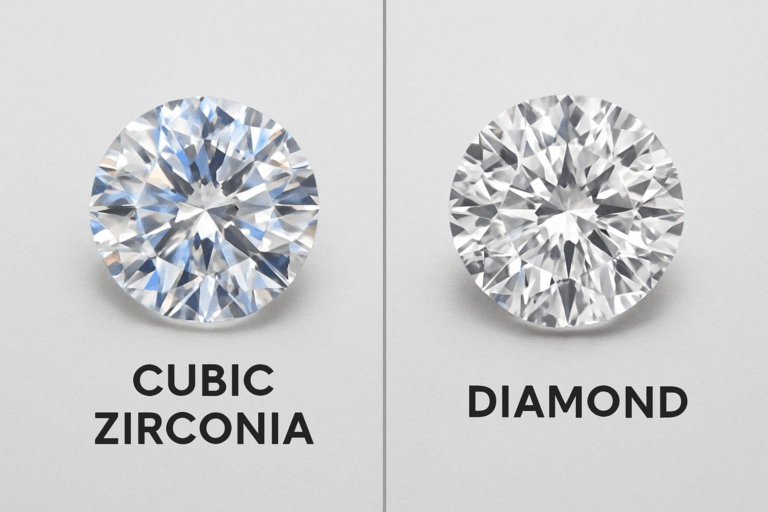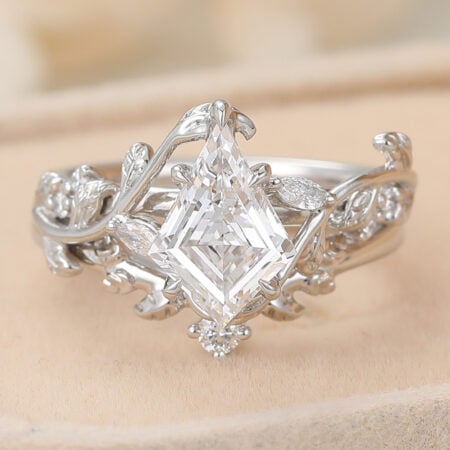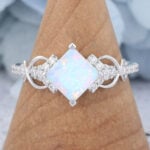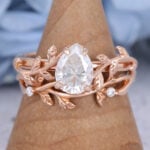Cubic Zirconia vs Diamond: Cost, Durability, and Appearance Compared
When choosing a gemstone for jewelry, many people compare cubic zirconia vs diamond to understand which is the better fit for their needs. Both stones are popular for rings, necklaces, and earrings, yet they differ greatly in cost, durability, and appearance. Knowing the distinctions between the two helps buyers make a confident and practical decision. This article comprehensively compares the differences between the cubic zirconia and a diamond to help you choose.
What is a Diamond?
The definition of diamond is a natural mineral made purely of carbon, created billions of years ago in the Earth’s deep layers under intense heat and pressure. With its highly stable crystal structure, diamond is recognized as the hardest substance in nature. Its unmatched durability and brilliance have made it a timeless favorite in the jewelry industry.
What is Cubic Zirconia?
The abbreviation of cubic zirconia is CZ, which is a synthetic crystalline material made from zirconium dioxide under laboratory conditions. Although CZ is not a natural gemstone, its low cost, diamond-like appearance, and wide availability have made it one of the most common alternatives to diamonds.

Cubic Zirconia vs Diamond Side By Side
Cost Comparison
When purchasing jewelry, price is a key concern for many consumers. Natural diamonds are scarce, and their cost is influenced by the “4Cs”: Carat, Cut, Clarity, and Color. As a result, larger diamonds with higher quality are significantly more expensive.
In contrast, material of cubic zirconia is almost entirely lab-created, with low production costs and a short manufacturing cycle. Even though it closely resembles a diamond in appearance, the price of cubic zirconia is typically only a small fraction of that of a diamond of the same size, making it an attractive option for budget-conscious buyers.
Durability Comparison
It is well known that diamonds are the hardest natural substance. Diamond hardness reaches 10 on the Mohs scale (1–10), meaning diamonds are extremely hard, almost impossible to scratch, highly durable, and can even be passed down as heirlooms.
In comparison, cubic zirconia hardness is around 8–8.5. Although slightly lower than diamonds, CZ is still very wear-resistant and not easily scratched, making it suitable for everyday jewelry as well.
Appearance Comparison
Diamonds are renowned for their unique optical properties. Their high refractive index and moderate dispersion create brilliant fire and a natural sparkle under light, giving them an elegant and enduring shine. Diamonds also come in a wide range of colors, from completely colorless to faint hues, and natural inclusions add distinctive character to each stone.
In comparison, white cubic zirconia gemstone closely resembles diamonds in appearance but has notable differences. CZ typically has a higher refractive index and dispersion than diamonds, making it appear even more sparkly—sometimes excessively so—lacking the natural subtlety of a diamond. CZ usually exhibits uniform color and no inclusions, resulting in a flawless, perfectly clear appearance.
Symbolism and Perception
Diamonds are regarded as symbols of commitment and eternity in love, which makes diamond engagement rings and wedding bands especially popular. The rarity of natural diamonds further represents the uniqueness of a partner, conveying the preciousness of someone truly special.
In contrast, cubic zirconia gemstones, being lab-created, offer a sparkling appearance at an affordable price but lack the history, rarity, and symbolic significance of natural diamonds. CZ is generally seen as a budget-friendly decorative option, ideal for those seeking fashionable jewelry or pieces for short-term wear.
Weight and Density
Beyond appearance and durability, weight and density are also important factors when choosing jewelry. Diamonds have a density of approximately 3.5–3.53 g/cm³, giving them a moderate weight for their size and a comfortable feel when worn. Their weight is well-balanced with their visual size, making them appear elegant without feeling bulky.
In contrast, cubic zirconia gemstones typically has a density of 5.6–6.0 g/cm³, significantly higher than that of diamonds. This means that a CZ stone of the same size will feel noticeably heavier, providing a stronger sense of presence when worn, but it may also feel somewhat bulky. The higher density can also affect the balance of rings or necklaces, which should be taken into consideration in the design.
Heat and Thermal Conductivity
Diamonds have an exceptionally high thermal conductivity, which is one of their unique physical properties. This is also the principle used by many diamond testers, such as thermal conductivity meters, to distinguish diamonds from other gemstones. Because diamonds can quickly dissipate heat, they remain comfortable and safe to wear even for extended periods.
In contrast, cubic zirconia has a much lower thermal conductivity. Due to this lower heat transfer, it is easy to determine whether a gemstone is a real diamond or cubic zirconia using thermal testing devices.
Ethical and Environmental Considerations
The mining of natural diamonds can not only damage the environment, causing soil erosion and water pollution, but also involves the issue of conflict diamonds.
In contrast, cubic zirconia is almost entirely lab-created and does not involve any mining. As a result, it does not harm the natural environment and is free from conflict or labor exploitation issues.
Availability and Variety
Natural diamonds offer a wide range of colors, cuts, and sizes, but high-quality, large, or rare-colored diamonds can be difficult to find and come with a premium price. This means that while diamonds provide unique and valuable options, acquiring certain specifications may require more time and investment.
In contrast, cubic zirconia is lab-created, allowing for abundant supply and quick production. CZ can be made in virtually any size, color, or cut, including vibrant hues that are rare in natural diamonds. This makes CZ highly versatile for designers and consumers seeking a wide variety of styles or personalized jewelry options.
Popular Uses in Jewelry
In jewelry applications, diamonds and cubic zirconia each have their own niche and unique characteristics. Diamonds, due to their rarity and symbolic meaning, are often used in engagement rings, wedding rings, and high-end jewelry. As symbols of eternity and commitment, they hold an irreplaceable place in important occasions and anniversaries. Diamonds’ exceptional hardness and brilliance make them a symbol of luxury and status.
In contrast, cubic zirconia jewelry is widely popular due to its affordability and accessibility. It is often used in fashion jewelry, as well as in everyday rings, earrings, necklaces, and bracelets, satisfying consumers who desire sparkling beauty without the high cost.

How to Tell Cubic Zirconia from Diamond
- Weight Comparison: Cubic zirconia has a higher density than diamond. For a similar size, cubic zirconia weighs approximately 1.7 times as much as diamond. The weight difference is clearly noticeable when weighed on a precision electronic scale.
- Refractive Index: Diamond has a refractive index of 2.42, while cubic zirconia is approximately 2.15. Diamond has a more intense brilliance and sparkle, while cubic zirconia has a more glassy, shimmering appearance.
- Fire: Diamond has a dispersion value of 0.044, resulting in a rich and natural fire, while cubic zirconia has a dispersion value of 0.060, resulting in an overly dazzling fire, even with a rainbow-like effect. The two can be distinguished by observing their fire.
- Hardness Test: Diamond has a Mohs hardness of 10, making it the hardest known natural substance. Cubic zirconia, with a hardness of only 8-8.5, is more susceptible to scratching. A hardness test can effectively distinguish them.
- Thermal Conductivity: Diamonds are highly conductive to heat, while CZ has a lower thermal conductivity. When tested with a thermal conductivity meter (diamond test pen), diamonds will conduct heat rapidly, while CZ will fail the test.
- Internal Characteristics: Natural diamonds often have inclusionssuch as pinpoints and feathers, while CZ is typically synthetic and virtually flawless, appearing too perfect. The difference can be detected with a magnifying glass.
- Ultraviolet Fluorescence: Under ultraviolet light, many diamonds fluoresce blue or other colors, while CZ generally exhibits no or only a weak fluorescence.
Cubic Zirconia vs Diamond: Pros and Cons Summary
Pros And Cons Of Natural Diamonds
Pros of Natural Diamonds
Exceptional Hardness: Diamonds score 10 on the Mohs scale, making them the hardest known natural material.
High Value: Natural diamonds often retain or increase in value over time.
Symbolic Significance: Traditionally associated with love, commitment, and luxury.
Cons of Natural Diamonds
High Cost: Natural diamonds are significantly more expensive than alternatives like cubic zirconia or lab diamonds.
Ethical Concerns: Some diamonds may be linked to conflict or poor mining conditions.
Environmental Impact: Mining causes land disruption, water usage, and carbon emissions.
Pros And Cons Of Cubic Zirconia
Pros of Cubic Zirconia
Affordable: CZ is much less expensive than natural diamonds, making it ideal for budget-friendly jewelry.
Brilliant Appearance: It closely mimics the sparkle and shine of diamonds, making it visually appealing.
Variety: Available in many colors, sizes, and cuts, allowing for diverse jewelry designs.
Cons of Cubic Zirconia
Softer: CZ has a lower hardness (8–8.5 Mohs) than diamonds, making it more prone to scratches.
Less Durable: Over time, it can lose brilliance and show wear faster than diamonds.
No Investment Value: Unlike diamonds, CZ lacks rarity and long-term value.
Artificial Look: Its sparkle may appear slightly exaggerated or less natural under certain lighting.
Conclusion
In conclusion, when comparing cubic zirconia vs diamond, both have their unique advantages and limitations. Choose your right gemstone according your needs.
FAQs About Cubic Zirconia vs Diamond
Is cubic zirconia real?
Yes, cubic zirconia is real in the sense that it is a synthetic gemstone made in a lab. It is not a natural mineral like diamonds.
What does CZ mean in jewelry?
CZ stands for cubic zirconia, a popular lab-created gemstone used as a diamond alternative.
What is a cubic zirconia made of?
Cubic zirconia is made of zirconium dioxide (ZrO₂), which is crystallized in a lab to create a gemstone.
Does cubic zirconia tarnish or turn green?
No, cubic zirconia does not tarnish or turn green. It is chemically stable and retains its appearance with proper care.
Is cubic zirconia good?
Yes, cubic zirconia is valued for its affordability, durability, and diamond-like sparkle, making it great for fashion jewelry.
Are lab grown diamonds cubic zirconia? What is the difference between cubic zirconia and a diamond?
No, lab-grown diamonds are real diamonds with the same chemical and physical properties as natural diamonds. Cubic zirconia is a different synthetic material that only mimics a diamond’s appearance.
Is cubic zirconia a mineral?
No, cubic zirconia is not a natural mineral; it is a man-made crystalline material.
How much is cubic zirconia worth?
Cubic zirconia is inexpensive, usually just a few dollars per carat, depending on size and quality.
How long do cubic zirconias last?
With proper care, cubic zirconia can last for many years, though it may show scratches or lose brilliance faster than diamonds.



